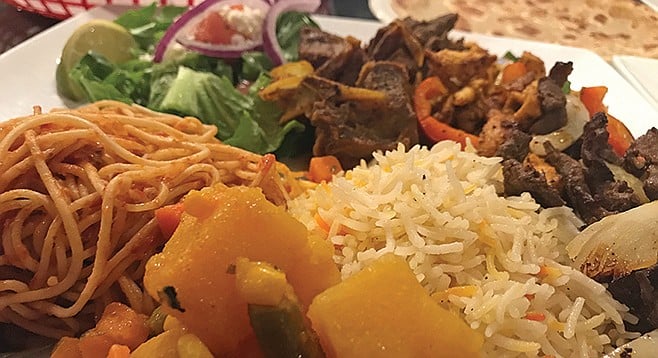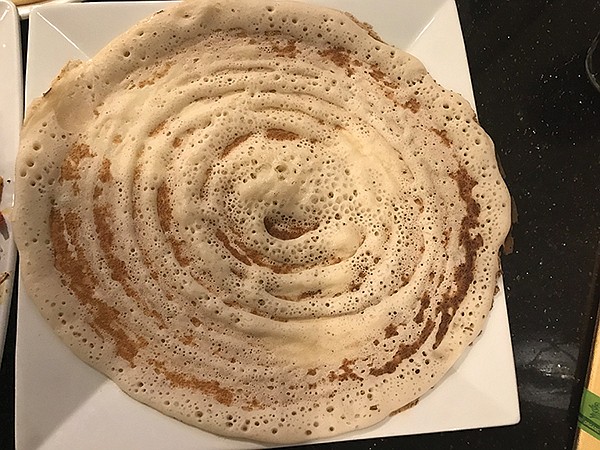 Facebook
Facebook
 X
X
 Instagram
Instagram
 TikTok
TikTok
 Youtube
Youtube

So what is the difference between Ethiopian and Somali food?
Last week, when my friend Annie and I were in Addis, a newish Ethiopian eatery on El Cajon Boulevard, two ladies came to eat at the next “tent.”
“You should try Somali food,” said one of them, Ayan. “We’re Somali. We live next door to Ethiopia, but we are different.”

Turned out her auntie, Farida, has a Somali restaurant on Euclid.
Could I resist?
Uh, no.
It’s five on a Friday night, and I’ve jes’ gotten off the 955 bus where 54th splits off from Euclid. And here, next to Awa African Hair Braiding, it sits: Farida’s, with tiled floors and green and brown paisley walls, and already busy.
“A bit more ginger, please! Love ginger in my coffee,” guy in the black leather jacket is saying to the Somali girl behind the counter. He turns to me. “This coffee’s as near as you can get to the coffee in my country.”
“Which is that?” I say.
“The world’s newest nation,” he says with pride. “South Sudan.”
His name’s Peter Wani. “I drive ten miles every day, just to get this coffee. And they only charge a dollar. Compare that to Starbucks!”
Ayan is here, helping her cousins.
“You’ll see,” she says. “It’s like a community center. We even have a place where people can pray, out back.”

Now I look around, you do get the flavor of Africa. There are pictures of mothers braiding their daughters’ hair, ancient Somali towers, elephants leading their babies, tail to trunk. They have pictures of men in white, dancing what Ayan says is called Dhaanto, a Somali dance which came from the dervish tradition. And on the TV, a couple is dancing side by side, singing to each other. “Somalis are known for their poetry and love songs,” says Ayan.
So I sit down and start checking out their menu. The one obvious thing that says Somali and not Ethiopian is bananas. Somalis love to mix in bananas with their main meals, whether it’s rice or pasta, with beef or chicken or goat or veggies. You actually mush them in with your right thumb and fingers so they add their sweetness to the savory tastes.
And that’s the other Somali thing: pasta. “Ethiopia is landlocked. Somalia has a huge coastline,” says Ayan. “So Somalia has fish, and we had invaders, like the Italians. They left pasta, which we made our own. But we also share so much food with Ethiopia, like anjero, which they call injera.”
Not that these two are exactly the same. Injera is made from an ancient, gluten-free grain called teff which is allowed to ferment for a couple of days, whereas Somali anjero is usually other grains, and only allowed to ferment overnight, so it’s much less sour.

All this is making me curious, and hungry as heck. Specially as I see feasts of meat, fish, veggies, potatoes, salad, yellow and red lentils passing by on great round trays.
“You should start with tea or coffee,” says Ayan. “I have to have tea, especially in the morning, with my anjero and beef or chicken suucqar.”
I see on the menu: “Somalian tea, with ginger, cinnamon, and cardamom, served black or with milk, $1.”
Great. A buck. Like the coffee. I get one. Truly delicious. Ginger sets up your appetite nicely. Of course, if you want to keep on drinking, they have mixed mango and mixed watermelon ($1 each).
“Suucqar?” I ask Ayan. Because I’m seeing it all over the menu.
“It means chopped up, cubed meat,” she says.
So what to eat? Basically, we’re talking chicken, beef, goat, or veggies with salad, and, say a “federation” (combo) of basmati rice and pasta (spaghetti, but Somalis never use the word “spaghetti”), and a potato and veggie mix-up.
Every plate goes for $11, but I go over the top. Get the 2-person “Sports Plate.” I get rice, and pasta, chicken, beef, and goat suucqar, salad, potato and veggie mix-up, and the tea included. I could have had fish, chicken legs, or a vegetarian option. Paid a dollar extra for the goat.
They specially make anjero for me (Somalis, unlike the Ethiopians, usually have anjero only at breakfast time, and it’s always cooked at the moment). It costs $1. Then Ayan also brings another special thick anjero called sabaayad (aka kimis, $2). This is eaten only in Somalia and Djibouti. It’s like an Indian paratha. Flour, water, salt, rolled out as a thicker pancake, briefly fried in a pan. Slightly crunchy, slightly delicious. But the stars? The three suucqar meats. Specially the goat. Boney but rich, tender, and no, not gamey.
And let’s not forget the banana. Here’s the thing. It somehow defines Somali tastes. “Hundreds of types of banana grow in Somalia,” Ayan says. “But even here, where there are only one or two, the taste’s important for us.”
What’s the same as in Ethiopia: Somalis prefer fingers to forks. So, people wash their hands before every meal, to feel the pleasure of food from fingers to mouth with no clacking cutlery to interrupt the sensual exchange of touch and flavor. It grows on you. Plus, with Somali food, you squish and fold your banana into the rice, meat, pasta, before you start.
And, new lesson in banana peeling tonight! When Ayan sees me struggling to peel my banana without a sharp knife, she takes it, goes to the bottom of the banana, and rips it open easily. Who knew?
Next really cheap treat: Hot anjero with butter, brown sugar, and tea for breakfast. Three buckeroos! Beat that, Starbucks.


So what is the difference between Ethiopian and Somali food?
Last week, when my friend Annie and I were in Addis, a newish Ethiopian eatery on El Cajon Boulevard, two ladies came to eat at the next “tent.”
“You should try Somali food,” said one of them, Ayan. “We’re Somali. We live next door to Ethiopia, but we are different.”

Turned out her auntie, Farida, has a Somali restaurant on Euclid.
Could I resist?
Uh, no.
It’s five on a Friday night, and I’ve jes’ gotten off the 955 bus where 54th splits off from Euclid. And here, next to Awa African Hair Braiding, it sits: Farida’s, with tiled floors and green and brown paisley walls, and already busy.
“A bit more ginger, please! Love ginger in my coffee,” guy in the black leather jacket is saying to the Somali girl behind the counter. He turns to me. “This coffee’s as near as you can get to the coffee in my country.”
“Which is that?” I say.
“The world’s newest nation,” he says with pride. “South Sudan.”
His name’s Peter Wani. “I drive ten miles every day, just to get this coffee. And they only charge a dollar. Compare that to Starbucks!”
Ayan is here, helping her cousins.
“You’ll see,” she says. “It’s like a community center. We even have a place where people can pray, out back.”

Now I look around, you do get the flavor of Africa. There are pictures of mothers braiding their daughters’ hair, ancient Somali towers, elephants leading their babies, tail to trunk. They have pictures of men in white, dancing what Ayan says is called Dhaanto, a Somali dance which came from the dervish tradition. And on the TV, a couple is dancing side by side, singing to each other. “Somalis are known for their poetry and love songs,” says Ayan.
So I sit down and start checking out their menu. The one obvious thing that says Somali and not Ethiopian is bananas. Somalis love to mix in bananas with their main meals, whether it’s rice or pasta, with beef or chicken or goat or veggies. You actually mush them in with your right thumb and fingers so they add their sweetness to the savory tastes.
And that’s the other Somali thing: pasta. “Ethiopia is landlocked. Somalia has a huge coastline,” says Ayan. “So Somalia has fish, and we had invaders, like the Italians. They left pasta, which we made our own. But we also share so much food with Ethiopia, like anjero, which they call injera.”
Not that these two are exactly the same. Injera is made from an ancient, gluten-free grain called teff which is allowed to ferment for a couple of days, whereas Somali anjero is usually other grains, and only allowed to ferment overnight, so it’s much less sour.

All this is making me curious, and hungry as heck. Specially as I see feasts of meat, fish, veggies, potatoes, salad, yellow and red lentils passing by on great round trays.
“You should start with tea or coffee,” says Ayan. “I have to have tea, especially in the morning, with my anjero and beef or chicken suucqar.”
I see on the menu: “Somalian tea, with ginger, cinnamon, and cardamom, served black or with milk, $1.”
Great. A buck. Like the coffee. I get one. Truly delicious. Ginger sets up your appetite nicely. Of course, if you want to keep on drinking, they have mixed mango and mixed watermelon ($1 each).
“Suucqar?” I ask Ayan. Because I’m seeing it all over the menu.
“It means chopped up, cubed meat,” she says.
So what to eat? Basically, we’re talking chicken, beef, goat, or veggies with salad, and, say a “federation” (combo) of basmati rice and pasta (spaghetti, but Somalis never use the word “spaghetti”), and a potato and veggie mix-up.
Every plate goes for $11, but I go over the top. Get the 2-person “Sports Plate.” I get rice, and pasta, chicken, beef, and goat suucqar, salad, potato and veggie mix-up, and the tea included. I could have had fish, chicken legs, or a vegetarian option. Paid a dollar extra for the goat.
They specially make anjero for me (Somalis, unlike the Ethiopians, usually have anjero only at breakfast time, and it’s always cooked at the moment). It costs $1. Then Ayan also brings another special thick anjero called sabaayad (aka kimis, $2). This is eaten only in Somalia and Djibouti. It’s like an Indian paratha. Flour, water, salt, rolled out as a thicker pancake, briefly fried in a pan. Slightly crunchy, slightly delicious. But the stars? The three suucqar meats. Specially the goat. Boney but rich, tender, and no, not gamey.
And let’s not forget the banana. Here’s the thing. It somehow defines Somali tastes. “Hundreds of types of banana grow in Somalia,” Ayan says. “But even here, where there are only one or two, the taste’s important for us.”
What’s the same as in Ethiopia: Somalis prefer fingers to forks. So, people wash their hands before every meal, to feel the pleasure of food from fingers to mouth with no clacking cutlery to interrupt the sensual exchange of touch and flavor. It grows on you. Plus, with Somali food, you squish and fold your banana into the rice, meat, pasta, before you start.
And, new lesson in banana peeling tonight! When Ayan sees me struggling to peel my banana without a sharp knife, she takes it, goes to the bottom of the banana, and rips it open easily. Who knew?
Next really cheap treat: Hot anjero with butter, brown sugar, and tea for breakfast. Three buckeroos! Beat that, Starbucks.